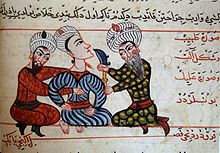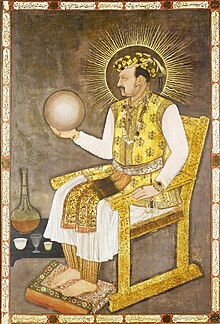
Ḥasan Ibn al-Haytham was a medieval mathematician, astronomer, and physicist of the Islamic Golden Age from present-day Iraq. Referred to as "the father of modern optics", he made significant contributions to the principles of optics and visual perception in particular. His most influential work is titled Kitāb al-Manāẓir, written during 1011–1021, which survived in a Latin edition. The works of Alhazen were frequently cited during the scientific revolution by Isaac Newton, Johannes Kepler, Christiaan Huygens, and Galileo Galilei.
Thābit ibn Qurra ; 826 or 836 – February 19, 901, was a polymath known for his work in mathematics, medicine, astronomy, and translation. He lived in Baghdad in the second half of the ninth century during the time of the Abbasid Caliphate.
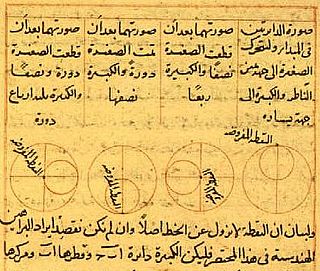
Science in the medieval Islamic world was the science developed and practised during the Islamic Golden Age under the Abbasid Caliphate of Baghdad, the Umayyads of Córdoba, the Abbadids of Seville, the Samanids, the Ziyarids and the Buyids in Persia and beyond, spanning the period roughly between 786 and 1258. Islamic scientific achievements encompassed a wide range of subject areas, especially astronomy, mathematics, and medicine. Other subjects of scientific inquiry included alchemy and chemistry, botany and agronomy, geography and cartography, ophthalmology, pharmacology, physics, and zoology.

Badīʿ az-Zaman Abu l-ʿIzz ibn Ismāʿīl ibn ar-Razāz al-Jazarī was a Muslim polymath: a scholar, inventor, mechanical engineer, artisan, artist and mathematician from the Artuqid Dynasty of Jazira in Mesopotamia. He is best known for writing The Book of Knowledge of Ingenious Mechanical Devices in 1206, where he described 50 mechanical devices, along with instructions on how to construct them. He is credited with the invention of the elephant clock. He has been described as the "father of robotics" and modern day engineering.

The House of Wisdom, also known as the Grand Library of Baghdad, was a major Abbasid-era public academy and intellectual center in Baghdad. It was one of the world's largest public libraries during the Islamic Golden Age, and was founded either as a library for the collections of the fifth Abbasid caliph Harun al-Rashid in the late 8th century or as a private collection of the second Abbasid caliph al-Mansur to house rare books and collections of poetry in the Arabic language. During the reign of the seventh Abbasid caliph al-Ma'mun, it was turned into a public academy and a library.
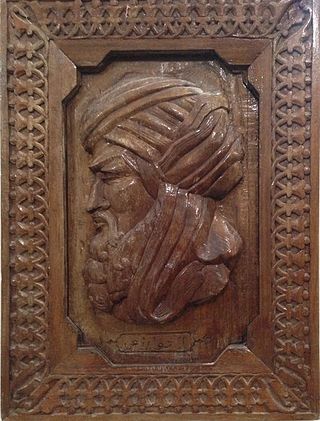
Muhammad ibn Musa al-Khwarizmi, often referred to as simply al-Khwarizmi, was a Persian polymath who produced vastly influential Arabic-language works in mathematics, astronomy, and geography. Hailing from Khwarazm, he was appointed as the astronomer and head of the House of Wisdom in the city of Baghdad around 820 CE.

Taqi ad-Din Muhammad ibn Ma'ruf ash-Shami al-Asadi was an Ottoman polymath active in Cairo and Istanbul. He was the author of more than ninety books on a wide variety of subjects, including astronomy, clocks, engineering, mathematics, mechanics, optics and natural philosophy.
This timeline of science and engineering in the Muslim world covers the time period from the eighth century AD to the introduction of European science to the Muslim world in the nineteenth century. All year dates are given according to the Gregorian calendar except where noted.
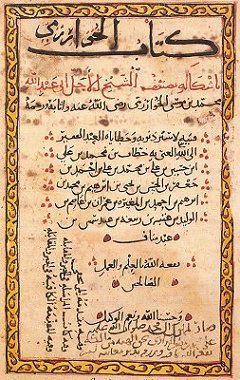
Mathematics during the Golden Age of Islam, especially during the 9th and 10th centuries, was built on Greek mathematics and Indian mathematics. Important progress was made, such as full development of the decimal place-value system to include decimal fractions, the first systematised study of algebra, and advances in geometry and trigonometry.

Medieval Islamic astronomy comprises the astronomical developments made in the Islamic world, particularly during the Islamic Golden Age, and mostly written in the Arabic language. These developments mostly took place in the Middle East, Central Asia, Al-Andalus, and North Africa, and later in the Far East and India. It closely parallels the genesis of other Islamic sciences in its assimilation of foreign material and the amalgamation of the disparate elements of that material to create a science with Islamic characteristics. These included Greek, Sassanid, and Indian works in particular, which were translated and built upon.
The three brothers Abū Jaʿfar, Muḥammad ibn Mūsā ibn Shākir ; Abū al‐Qāsim, Aḥmad ibn Mūsā ibn Shākir and Al-Ḥasan ibn Mūsā ibn Shākir, were Persian scholars who lived and worked in Baghdad. They are collectively known as the Banū Mūsā.

The Book of Ingenious Devices is a large illustrated work on mechanical devices, including automata, published in 850 by the three brothers of Persian descent, the Banū Mūsā brothers working at the House of Wisdom in Baghdad, Iraq, under the Abbasid Caliphate. The book described about one hundred devices and how to use them.
Donald Routledge Hill was a British engineer and historian of science and technology best known for his translation of The Book of Knowledge of Ingenious Mechanical Devices of the Muslim engineer Ismail al-Jazari.

During the High Middle Ages, the Islamic world was at its cultural peak, supplying information and ideas to Europe, via Al-Andalus, Sicily and the Crusader kingdoms in the Levant. These included Latin translations of the Greek Classics and of Arabic texts in astronomy, mathematics, science, and medicine. Translation of Arabic philosophical texts into Latin "led to the transformation of almost all philosophical disciplines in the medieval Latin world", with a particularly strong influence of Muslim philosophers being felt in natural philosophy, psychology and metaphysics. Other contributions included technological and scientific innovations via the Silk Road, including Chinese inventions such as paper, compass and gunpowder.

The concept of engineering has existed since ancient times as humans devised fundamental inventions such as the pulley, lever, and wheel. Each of these inventions is consistent with the modern definition of engineering, exploiting basic mechanical principles to develop useful tools and objects.

The Islamic Golden Age was a period of scientific, economic and cultural flourishing in the history of Islam, traditionally dated from the 8th century to the 13th century.
Roshdi Rashed, born in Cairo in 1936, is a mathematician, philosopher and historian of science, whose work focuses largely on mathematics and physics of the medieval Arab world. His work explores and illuminates the unrecognized Arab scientific tradition, being one of the first historians to study in detail the ancient and medieval texts, their journey through the Eastern schools and courses, their immense contributions to Western science, particularly in regarding the development of algebra and the first formalization of physics.

The Book on the Measurement of Plane and Spherical Figures was the most important of the works produced by the Banū Mūsā. A Latin translation by the 12th century Italian astrologer Gerard of Cremona was made, entitled Liber trium fratrum de geometria and Verba filiorum Moysi filii Sekir. The original work in Arabic was edited by the Persian polymath Naṣīr al‐Dīn al‐Ṭūsī in the 13th century. The original work in Arabic is not extant, but its contents are known from later translations.
